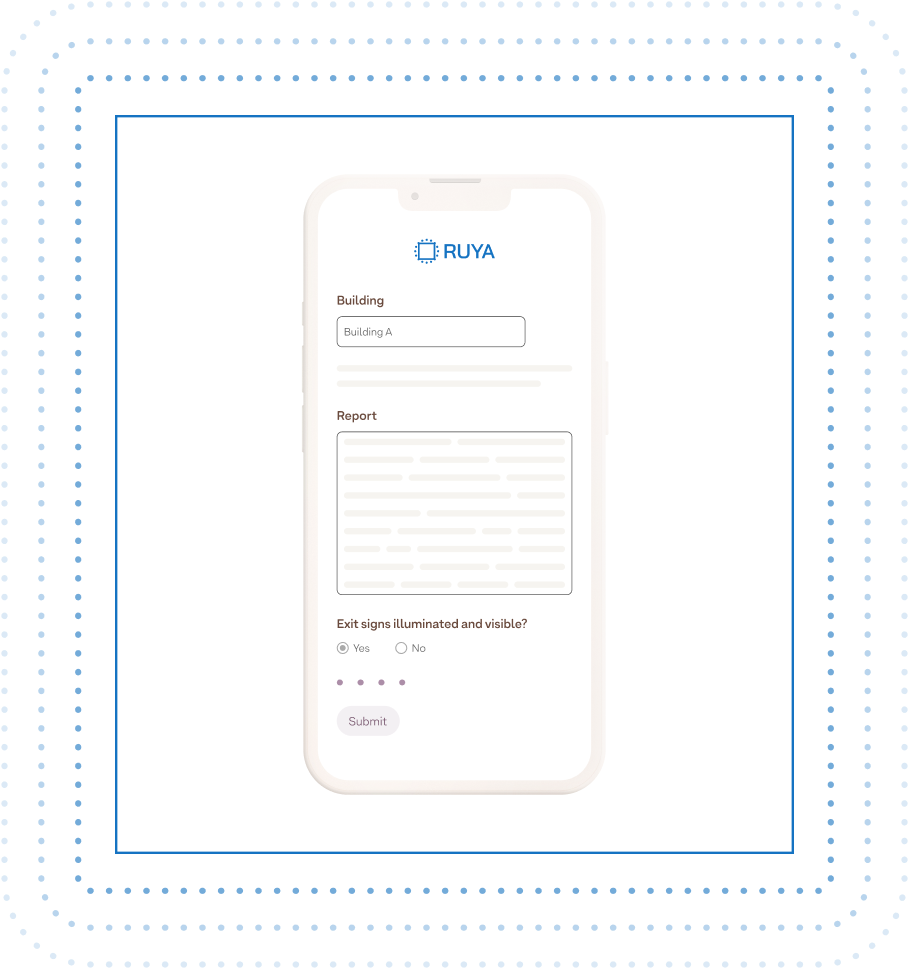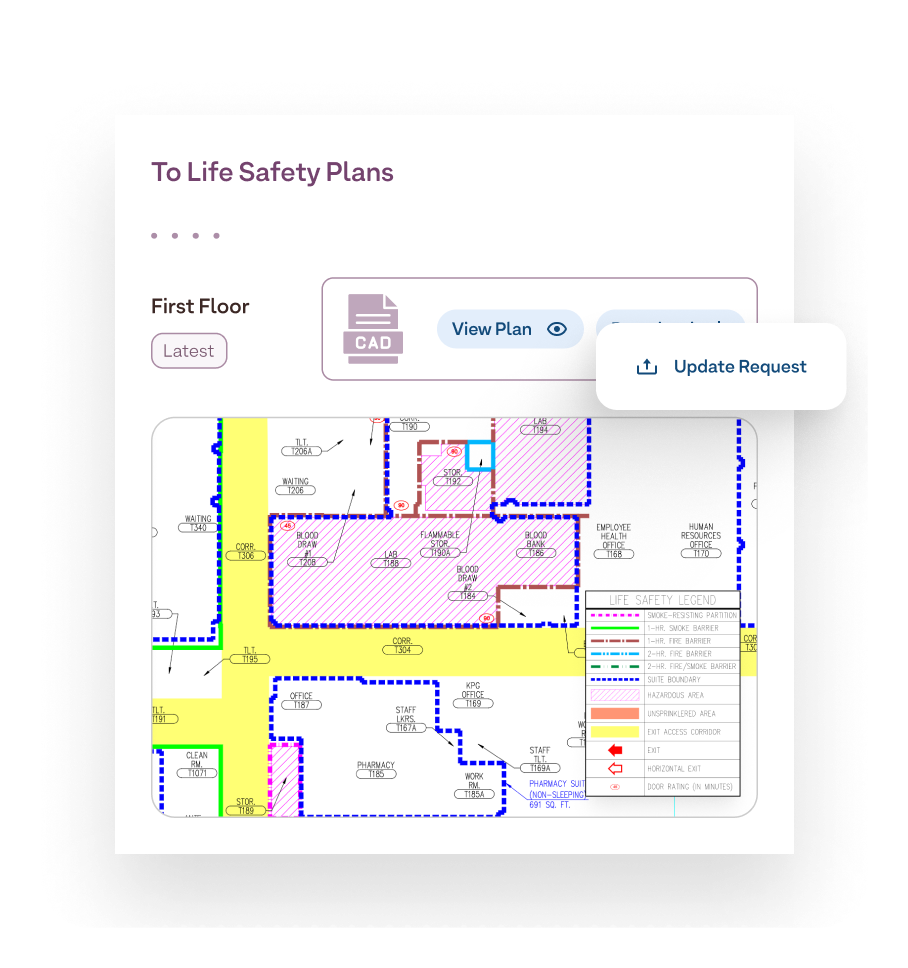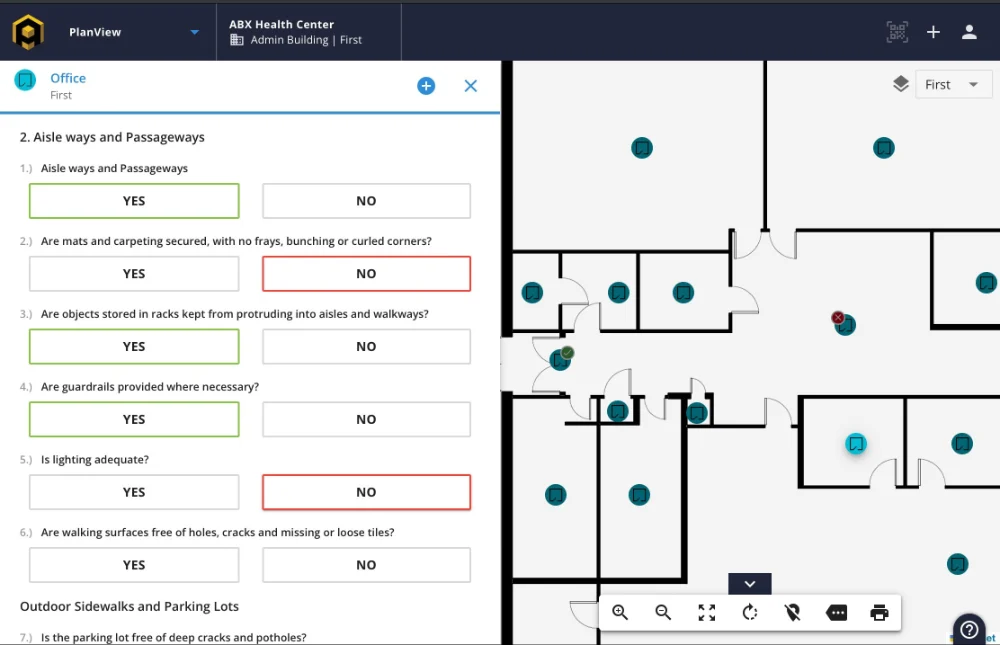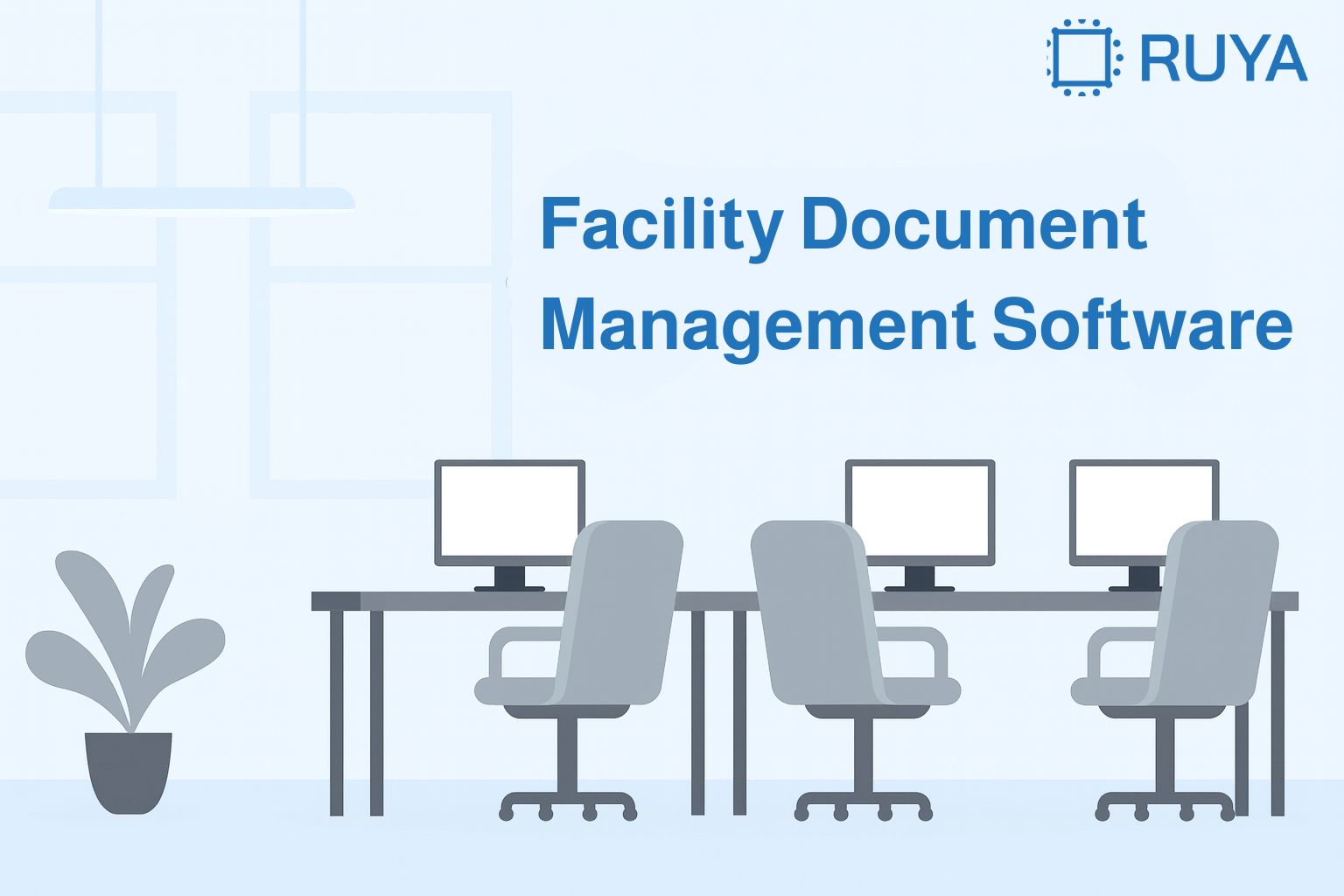We Review 7 Best Hospital Facility Management Software Solutions to Improve Your Healthcare Operations

Quick Summary
This guide reviews five of the best hospital facility management software tools built for healthcare. Each platform can help streamline maintenance, support compliance, and manage safety across large facilities. Compare features, pricing, pros, and cons to find the right match for your hospital operations.
Looking for the best healthcare facility management software?
Managing a hospital is a constant balancing act. With 24/7 operations, tight safety codes, and regular inspections, traditional tools like paper checklists can’t keep up. They lack the real-time updates, mobile access, and team coordination that hospitals need.
Healthcare facility management software is the answer. These specialized platforms bring together everything you need, from floor plans and maintenance to inspections and vendor management, into one easy-to-use system. The result is a safer, more efficient hospital that stays compliant.
In this Ruya article, we’ll cover the top 7 hospital facility management software solutions that are reshaping healthcare operations. Whether you want to simplify maintenance, improve safety, or boost collaboration, we’ve got you covered.
Why listen to us?
At Ruya Compliance, we support over 200 hospitals across the U.S., helping teams manage inspections, floor plans, and vendors with less IT friction. Our platform was specifically built for seamless healthcare facility management.

What is hospital facility management software?
Hospital facility management software is a specialized platform designed to streamline the day-to-day operations of healthcare facilities. It helps teams manage everything from maintenance and inspections to compliance tasks and floorplan updates, all in one place.
Unlike general-purpose tools, hospital facility management software is tailored to the unique demands of healthcare settings. For example, it provides real-time updates, so if a maintenance issue arises, teams can respond immediately, preventing costly delays. Safety checklists ensure that every corner of the facility meets the necessary health and safety regulations. Plus, secure vendor access allows facilities to easily track service providers and ensure their work is up to standard.
With these features, hospital teams can work faster, reduce errors, stay compliant, and most importantly, maintain a safe environment for patients and staff.
Why is hospital facility management software important?
- Keeps hospital operations running smoothly: By organizing maintenance schedules and tracking repairs, it helps prevent unexpected downtime. This ensures patients and staff aren't impacted by delays or safety issues.
- Supports compliance and inspections: Healthcare facilities must meet strict standards from regulators like CMS and The Joint Commission. Software makes it easier to complete checklists, store records, and stay audit-ready.
- Improves visibility across departments: Everyone, from facilities to clinical staff, needs access to accurate building data. A shared system reduces the risk of miscommunication and speeds up decisions.
- Enables mobile, on-the-go work: Teams can complete inspections, log issues, and review plans from their phones or tablets. This removes delays caused by paper forms or desktop-only systems.
- Simplifies coordination: Software like Ruya helps hospitals manage floor plans, inspections, and vendors in one place, with real-time updates and mobile access without the need for a heavy IT setup.
7 best hospital facility management software platforms
- Ruya
- Akita Box
- FMX
- TMA Systems
- eMaint
- Nuvolo
- QuickFMS
1. Ruya

Ruya is a purpose-built platform designed specifically for managing the complexities of hospital facilities. It serves as a central hub for overseeing inspections, maintenance, compliance, and vendor collaboration across multiple campuses, ensuring seamless operations from the ground up.
For hospital administrators and facilities directors, Ruya offers real-time access to crucial data, whether it’s reviewing floor plans or coordinating with external vendors. And for healthcare systems spanning multiple sites, Ruya streamlines communication and ensures everyone stays aligned, no matter where they are.
Key Features
- CAD/BIM Viewer: Allows users to view and update architectural files (DWG, Revit, PDF) without needing third-party software.

- Mobile Inspections: Empowers field teams to complete code-compliant inspections using mobile devices.

- Checklist Automation: Standardizes checklists for ICRA, EOC rounds, and life safety procedures to streamline audits.
- Role-Based Access: Gives contractors, architects, and consultants controlled access without involving hospital IT teams.
- Per-Building Organization: Keeps assets, drawings, and vendor data organized by individual hospital building or campus.
- Life Safety Plan Collaboration: Enables stakeholders to review and update life safety plans remotely, without having to connect to your hospital network.

- Reduced IT Reliance: Operates independently of core hospital IT systems, enabling fast deployment and easier onboarding.
Pricing
We offer custom pricing based on the number of campuses and required modules. Contact us for a tailored quote.
Pros
- Developed specifically for healthcare environments.
- Simplifies inspections and compliance reporting.
- Fast deployment with minimal training required.
- Streamlines construction-to-operations handoff.
Cons
- CAD/BIM features may require basic user orientation for new teams.
2. AkitaBox

AkitaBox is a cloud-based facility management platform that enables healthcare organizations to view building data, manage space, and plan long-term maintenance needs. It’s useful for healthcare facilities looking for a user-friendly, visually intuitive platform with strong asset and inspection management.
Key Features
- Interactive Floorplan-Based Asset Tracking: Displays facility assets to improve asset management and operational coordination.
- Work Order Management: Simplifies work order generation, tracking, and completion to improve maintenance efficiency.
- Capital Planning Modules: Assists in planning and budgeting for long-term facility investments and upgrades.
- Preventive Maintenance Scheduling: Schedules regular maintenance tasks to extend asset lifecycles and avoid costly breakdowns.
- Space Utilization Data Tools: Tracks and analyses space usage to help optimize hospital floor plans.
Pros
- Clear display interface tied to building layouts.
- Supports long-term asset management and capital forecasting.
- Cloud-based with easy access for teams across departments.
Cons
- Healthcare-specific compliance tools (e.g., ICRA, EOC) are not as robust.
- May require some customization to match hospital inspection workflows.
3. FMX

FMX delivers a flexible platform with configurable maintenance and operational workflows, asset tracking, and reporting tools that scale across multi-site hospital systems. It adapts to complex structures with customizable inspection calendars and approval chains.
Key Features
- Work Order Tracking: Tracks maintenance tasks from creation to completion with custom approval workflows.
- Asset and Inventory Management: Manages hospital assets, supplies, and parts inventory efficiently.
- Preventive Maintenance Scheduling: Schedules and tracks preventive maintenance tasks to reduce emergency repairs.
- Custom Reporting: Generates detailed reports on asset performance, maintenance costs, and operational efficiency.
- Calendar-Based Inspections: Sets up inspections and equipment checks using a dynamic calendar system.
Pros
- Highly customizable workflows to match complex team structures.
- Scalable for multi-site hospital systems.
- Includes inventory and vendor management in one platform.
Cons
- May require time to configure for hospital-specific compliance needs.
- Its interface can feel overwhelming for smaller teams.
4. TMA Systems

TMA Systems offers mature asset lifecycle management tools, strong preventive maintenance planning, and engineering workflows. It’s widely used in large hospital plants, though its desktop-heavy structure is less suited to mobile frontline staff.
Key Features
- Preventive and Corrective Maintenance Scheduling: Automates maintenance schedules and tracks issues for timely resolutions.
- Asset Lifecycle Management: Tracks assets through their lifecycle for proper upkeep and timely replacement.
- Work Order Management: Generates and manages work orders to optimize workflow efficiency.
- Integration with Building Automation Systems (BAS): Integrates with existing hospital systems for comprehensive facility management.
- Capital Planning: Helps hospitals plan and budget for future facility needs based on asset performance.
Pros
- Reliable for long-term asset tracking.
- Comprehensive reporting for maintenance planning and compliance.
- Ideal for engineering departments in healthcare and education.
Cons
- Desktop-first design can limit accessibility in the field.
- Mobile capabilities and interface feel dated compared to newer platforms.
5. eMaint

eMaint offers a full-featured CMMS platform that integrates with IoT or Fluke monitoring sensors and supports heavy-duty asset tracking. It suits hospitals that can support a more technical installation to gain enterprise reporting and dashboards.
Key Features
- Work Order Automation: Automates the creation and assignment of work orders.
- Asset Performance Monitoring: Tracks asset health and provides condition-based maintenance recommendations.
- Custom Dashboards and Reporting: Creates tailored dashboards and real-time reports to enhance decision-making.
- Integration with Fluke Sensors: Integrates seamlessly with Fluke's industrial monitoring tools for real-time asset performance data.
- Mobile Access: Provides mobile access to facilities teams for on-the-go maintenance tracking and issue resolution.
Pros
- Customisable and scalable for enterprise-level use.
- Strong integration with industrial-grade monitoring tools.
- Extensive reporting and analytics for maintenance performance.
Cons
- Steeper learning curve and setup time.
- Lacks healthcare-specific compliance features unless customized.
6. Nuvolo

Nuvolo is a healthcare facility management platform built on the ServiceNow infrastructure. It provides integrations with electronic health records (EHRs), strong asset lifecycle tracking, and support for compliance, making it a good option for large hospital systems with intricate IT ecosystems.
Key Features
- EHR Integration: Integrates with popular EHR systems (like Epic and Cerner) to sync facility data with clinical records.
- Compliance Workflows: Provides built-in support for healthcare compliance, including safety checks and regulatory reporting.
- Work Order Management: Tracks and manages work orders from creation to completion, ensuring all tasks are addressed.
- Asset and Space Management: Handles both facility assets and space utilization for efficient operations.
- Real-Time Reporting: Generates real-time performance and compliance reports to aid decision-making.
Pros
- Tailored for healthcare, including support for Joint Commission and CMS requirements.
- Smooth integration with broader hospital IT systems.
- Scalable for multi-hospital networks and enterprise IT governance.
Cons
- Requires ServiceNow infrastructure and IT involvement.
- Higher cost and longer implementation timeline compared to lighter tools.
7. QuickFMS

QuickFMS is a versatile facility management platform that is beneficial to various industries, including healthcare. It has a cloud-based architecture that makes it suitable for hospitals looking to optimize their facility operations.
Key Features
- Asset Management: Tracks and manages the lifecycle of medical and facility assets with condition-based monitoring.
- Space Management: Optimizes space utilization and room bookings, ensuring efficient hospital floor planning.
- Preventive Maintenance: Schedules and tracks maintenance tasks to avoid downtime and costly repairs.
- Work Order Management: Automates the creation, assignment, and tracking of work orders for operational efficiency.
- Mobile Access: Provides real-time data and updates to staff through a mobile app, ensuring timely action.
Pros
- Cloud-based platform with real-time data access.
- Comprehensive suite of features covering various aspects of facility management.
- User-friendly interface with mobile accessibility.
Cons
- May require customisation to fully align with specific healthcare compliance requirements.
- Integration with certain hospital systems may need additional configuration.
Criteria to consider when choosing hospital facility management software
Hospitals are run under strict regulations and high operational pressure, so the software that manages the facility must be intentional. When choosing your tool, you should consider the following features:
- Mobile-friendly inspections and issue tracking: Field staff should be able to complete inspections, log issues, and trigger work orders directly from a mobile device. This will minimize delays caused by using regular paper forms.
- Real-time updates to floor plans and asset records: Access to always-current CAD, BIM, or PDF drawings means maintenance teams and vendors work with accurate, synced building data.
- Role-based access for contractors, consultants, and vendors: External users should be able to view only what they need without exposing sensitive systems or requiring IT setup. For instance, custom platform-based permissions make collaboration fast and with low risk.
- Life safety and compliance checklist support: Built-in tools for ILSM and other regulatory requirements make inspections and audits faster and more accurate. These can be set up with auto-reminders and a timestamped audit trail for more efficient compliance.
- Cloud-based and easy to deploy: The platform should require minimal IT resources and allow teams to get started quickly. It could be a platform that operates in a browser and requires no desktop installation and less supervision.
Optimize your healthcare operations with the right hospital facility management software
In today’s fast-paced healthcare environment, basic asset tracking isn’t enough. Hospitals need a comprehensive platform that seamlessly integrates compliance, safety, inspections, and maintenance management. Tools like Ruya provide healthcare teams with a single, reliable source of truth, offering real-time access to critical data and ensuring smooth coordination across departments.
By streamlining operations and improving efficiency, Ruya helps healthcare systems stay compliant, safe, and fully operational, no matter how complex the facility.
Ready to see how it can transform your operations? Book a demo today to experience Ruya’s full potential.

.svg)


